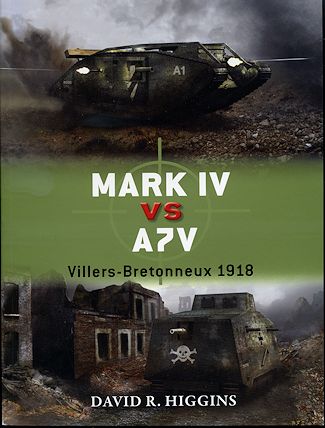
|
Author: |
David R. Higgins |
|
Publisher/Distributor |
Osprey Publishing |
|
Price |
$18.95 MSRP |
|
Reviewer: |
|
| Notes: |
80 pages, 7¼ x 9¼ inches, softcover ISBN: 978-1-78096-005-0 |

Like many things in war, what becomes important has to have a small start and it has to have a reason for being. So it is with the tank. Developed as a way to help soldiers break through the lines in trench warfare during WWI, it has evolved to something greater than what it was initially designed to accomplish.
Developed in secret by the British Navy, workers were told they were building 'water carriers for troops in Mesopotamia', hence 'tank'. Since it was a Navy project, they were 'land ironclads'. As we know, this quickly changed and it was the army that used them the most. The best of the original design was the Mark IV which was built in both all machine gun versions (females) and with cannon (males). Though the initial use at Cambrai was not quite as planned, they did show that they were pretty well impervious to the dreaded German machine guns. Despite issues with maneuverability over rough ground, reliability, and incredibly toxic interior environments, they were a big surprise to the Germans who eventually designed their own.
However, the German version, the A7V was quite different from the British Mark IVs and the smaller Whippet tanks. These were real behemoths with large crews and very large cannon as its major armament. However, like the British, it was a major learning experience for the Germans. Their tanks were also mechanically unreliable and even more ungainly over the broken ground of the battlefield. However, it was thanks to the large number of guns and the size of the main gun that made it a relatively potent weapon.
These tanks did not meet head to head until late in the war. It was in April of 1918 when the Germans had their last major push of the war in Operation Michael that the few tanks Germany had built, the A7V went into action. Though only 20 of these were made and not all saw combat, they were a nasty surprise to the British. They were pretty much unstoppable (when functioning properly) and helped to overrun a number of British positions during the initial push. Like all advances, great though it was, it soon ground to a halt. An effort to get it underway again brought, for the first time, British and German tanks into contact with each other. Despite the fact that any sort of accurate gunnery from a moving tank operating over broken ground was nigh near impossible, it was the German A7V with its larger gun that was able to knock out the British Mark IV. It is fortunate for the British that the Germans had so few of these weapons as things might have turned out differently had more been available earlier.
In this book by David Higgins, we get a good look at the development of these vehicles on both sides of the conflict, It is interesting that the brass of both nations were not sure these were a good idea. We are then given an opportunity to see what these tanks were like from a technical stand point and what they were like to operate. We then go into combat with them where these tank's positive and negative traits are discovered.
It makes for a fascinating look at these weapon's earliest days and see from whence the modern Main Battle Tank developed. It is another superb title in Osprey's Duel series and a book I know you will enjoy reading. Highly recommended.
February 2013
For more on the complete line of Osprey books, visit www.ospreypublishing.com. In the US, it is Osprey Direct at 443 Park Avenue South, New York, NY 10016, where you can get a catalogue of available books.
If you would like your product reviewed fairly and quickly, please contact me or see other details in the Note to Contributors.